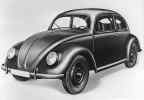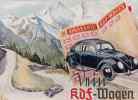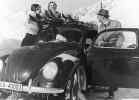VW Beetle
Right from the very beginning it was a special vehicle which Ferdinand Porsche constructed in 1934. It ought to be a small car and affordable for everyone. A sales price of 1,000 Reichsmark was set in advance. In 1935/36 the first prototypes rolled off the lines, which had still been built in Porsche’s garage in Stuttgart.
In 1938 the foundation stone was lad for a factory in which the “KdF” car should be constructed in series, because there was no shortage of orders: 270,000 cars were required, for which there was a savings system of its own with savings cards where at least 5 RM a week had to be paid in the form of savings stamps.
But then the Second World War broke out, and the factory had to produce military vehicles in black or grey until the plants were almost completely destroyed. During British occupation the factory was rebuilt and it was then that the story of success began for the car.
In post-war Germany the roads were full of adventurous constructions: three-wheeled vehicles, bubble cars without a reverse gear, cabrios without doors and “Leukoplastbombern” (small cars whose bodywork was made of artificial leather). That’s when the VW was the king with 4 cylinders and five seats. And it had a speed of over 100 km per hour. Its shape was very likeable, the rear engine was reliable and it was possible to drive safely through the winter, even if the heating only produced a faint warmth. But in the 50s heating systems weren’t a matter of course in cars anyway. The VW had two boots: one beneath the front bonnet and a hollow below the rear window behind the back seats, which was often used by families with small children as a mobile baby’s bed.
Unfortunately the VW could also bring the driver into great difficulties: the cable brakes never worked regularly, the rear axle had a fatal tendency to turn the car into a rear spin. But even careful drivers were in great trouble when the petrol was running out and they had to change to reserve. There was no petrol gauge, so that in some circumstances while overtaking the petrol tap had to be found right down in the foot area.
But it ran and ran and ran, and that wasn’t just an advertising gag. Repairs were not necessary for years at a time when other cars needed a new engine after 20,000 km.
The fact that the Beetle - as it was quickly called inofficially - also ran and ran and ran in the production, probably has to do with the emotions it evoked. For the Americans had enough larger, faster and more comfortable cars, but they still bought the Beetle by the million because they loved it.
And one could be seen everywhere in the Beetle. Its classless image was never reached by any other car. And so for decades it had its fans and even became the production world champion, long before the production was stopped in 2003.
Photos: Stiftung AutoMuseum Volkswagen











